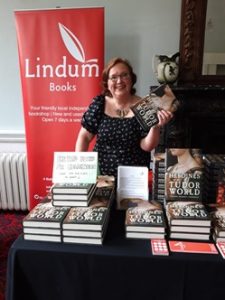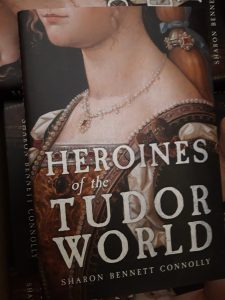‘Heroines of the Tudor World’ by Sharon Bennett Connolly was published by Amberley Publishing on 15th June.
Sharon is a Fellow of the Royal Historical Society and best-selling author of historical non-fiction. She also writes the popular history blog, www.historytheinterestingbits.com. She co-hosts the podcast A Slice of Medieval, alongside historical novelist Derek Birks.
Sharon regularly gives talks on women’s history, for historical groups, festivals and in schools; her book Silk and the Sword: The Women of the Norman Conquest is a recommended text for teaching the Norman Conquest in the National Curriculum. She is a feature writer for All About History and Living Medieval magazines and her TV work includes Australian Television’s ‘Who Do You Think You Are?’
Buy ‘Heroines of the Tudor World’:
Follow Sharon on Social Media:
Blog: History…the interesting bits
Podcast: A Slice of Medieval
Facebook: History: The Interesting Bits
X/Twitter: @thehistorybits
Many thanks to Sharon for answering my questions.
Why did you choose this subject for your book?
I have always had a fascination with the Tudors – who hasn’t? After the success of my first book, Heroines of the Medieval World, I did think the concept could transfer to any other era, but thought the Tudors would be perfect. What I didn’t count on was the amount of information and sources available, compared to the medieval era. I could write so much more for each chapter! So, I did go over my word count by about 30,000 words, but luckily my publisher didn’t mind (not sure where – or who – I could have cut, if they’d insisted on sticking to 100,000 words).
Of course, deciding to write Heroines of the Tudor World was only the start of the process – I had to then decide who to include in the book. I wanted to cover Henry VIII’s 6 wives, but I didn’t want them to take over the book. So, they are in there, but mainly as part of the stories of others. For instance, Anne Boleyn is included in Mary Boleyn’s story and Catherine Howard is part of Jane Parker’s story.
I did keep the same chapter titles as in Heroines of the Medieval World, so there is the Tudor Ideal, Warrior Heroines, Literary Heroines and The Survivors.
What does your book add to previous work covering these women
Oh, now there’s a question.
I am hoping that the way it is written – thematically, rather than chronologically – will make people look at these women from a different angle and give some food for thought.
I hope my book will allow people to look at Tudor women in a different light. The book is written thematically – although some of the women included could easily have appeared in several different chapters.
How did you decide on the thematic structure of the book and why did you choose the categories of heroine?
I didn’t have to think too much about this, as I decided to keep the same chapters as I used in Heroines of the Medieval World. With the first book, the idea was to choose a range of chapter headings that demonstrated the diversity and versatility of medieval women. And when I started writing Heroines of the Tudor World, I realised that those same chapters still worked.
It’s also easier, in that way, for those with both books to be able to compare how things had changed for – whether for better or worse is debatable.
What surprised you most researching this book?
When I wrote Heroines of the Medieval World, it was hard to find references to the women in question. You had to read behind the stories of the men to discover those of the women.
With Heroines of the Tudor World, the sheer amount of sources, and the fact women were more active in politics and religion, meant that the information was much more readily available. Which also gave me a problem. It meant I could write about each woman in much more detail – which meant I exceeded my proposed word count by an extra 30,000 words. But these women were amazing, so what should I have expected?
Do you think if Henry Brandon (son of Mary Tudor, Duchess of Suffolk) had survived, that he would have been accepted as King after Edward VI instead of Mary I?
Most definitely.
It was still very much a patriarchal society and I am sure that Henry VIII, when deciding the order of succession on his children and then the children of Frances Grey, Duchess of Suffolk, hoped that Frances, who had 3 daughters, may still have a son. And when Edward VI settled the succession on Jane Grey, disinheriting his half-sisters, the initial ‘devise’ for the succession was for the ‘heirs male’ of Jane’s body, rather than Jane herself. It was only changed in favour of Jane when Edward realised he would die before Jane became a mother.
If Henry Brandon, son of Mary Tudor, had been around, Edward would have settled the succession on him. And I do not think there would have been any who would support a female monarch who was closer to the crown ahead of a male candidate – they certainly hadn’t in the 12th century and the patriarchal manner of society had not changed much in the intervening 200 years.



































